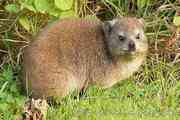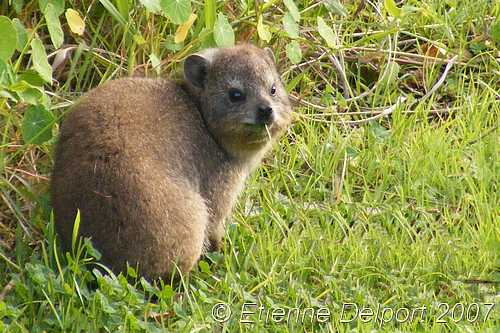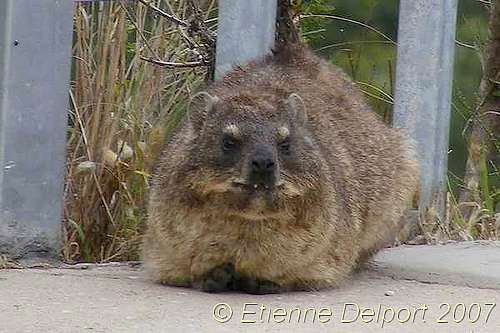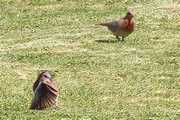| Conservation status | |
|---|---|
| Scientific classification | |
| Kingdom: | Animalia |
| Phylum: | Chordata |
| Class: | Mammalia |
| Order: | Hyracoidea |
| Family: | Procaviidae |
| Genus: | Procavia |
| Species: | P. capensis |
| Binomial name | |
| Procavia capensis Pallas, 1766 |
|
| Multinational names | |
| Afrikaans: | Klipdassie |
| French: | Daman de Rocher |
| German: | Kap-Klippschliefer |
| Spanish: | Damán de El Cabo |
| Xhosa / Zulu / Tsonga: | Mbila |
| Tswana / Sotho: | Pela |
Identification. The Rock Hyrax (Procavia capensis) grows to be about 45 to 60 cm in length and weighs between 2.5 and 4.5 kg, males being approximately 10% heavier than females. Their fur is thick and grey-brown in colour, although this varies strongly between different environments. It may vary from dark brown in wetter habitats to light grey in desert living individuals. Prominent in, and apparently unique to hyraxes, is the dorsal gland which excretes an odour used for social communication and territorial marking. The gland is most clearly visible in dominant males. The head of the rock hyrax is pointed, having a short neck with rounded ears. They have long black whiskers on their muzzles. The rock hyrax has a prominent pair of long, pointed tusk-like upper incisors. The forefeet are plantigrade, and the hindfeet semi-digitigrade. The soles of the feet have large, soft pads that are kept moist with sweat-like secretions.
Habitat. Rock Hyraxes occupy a wide range of habitats, from arid deserts to rainforest, occurring from sea level to 4,300 m on Mount Kenya. They are typically associated with rocky outcrops, cliffs or boulders. They require numerous cavities and crevices that are large enough to shelter in but small enough to discourage predators. These cavities often face away from strong prevailing winds, have good visibility of the surrounding habitat, and are close to to sunlit areas for basking and suitable foraging areas. The Rock Hyrax often uses basking and sheltering to control its body temperature, thus the location and layout of its rocky habitat is important – it needs easy access to basking spots when it is cold, as well as deep crevices to escape excessive heat.
Diet. Rock Hyraxes feed on a wide variety of different plants, including grasses, berries and broad leafed plants. They also have been reported to eat insects and grubs. The rock hyraxes forage for food up to about 50 m from their refuge, usually feeding as a group and with one or more acting as sentries from a prominent lookout position. They are able to go for many days without water due to the moisture they obtain through their food. They will readily climb trees to reach fresh leaves.
Call. A rather vocal species, the Rock Hyrax produces a series of intermittent harsh yips which build up to guttural grunts when defending its territory. A sharp bark is used to warn others if danger threatens.
Breeding. Rock Hyraxes give birth to 2 or 3 young after a 6 – 7 month gestation period. The young are well developed at birth with fully opened eyes and complete pelage. Young can ingest solid food after 2 weeks and are weaned at 10 weeks. Young are sexually mature after 16 months, reach adult size at 3 years, and typically live about 10 years.
South African Distribution. The Rock Hyrax occurs throughout most of South Africa. The only exception being the northern areas of the Kalahari Desert.
Port Elizabeth Area. The Rock Hyrax is abundant in the Baakens Valley and along the rocky Schoenmakerskop shoreline. Other large colonies can be seen along the Chatty River and in the Driftsands area.
Conservation Status – LC (Least Concern)1 Listed as Least Concern in view of its wide distribution, presumed large population, its occurrence in a number of protected areas, and because it is unlikely to be declining fast enough to qualify for listing in a more threatened category.
- IUCN Redlist – Rock Hyrax Fact Sheet ▲





